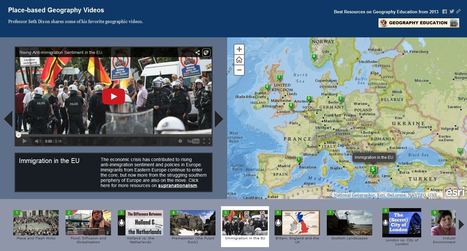 Your new post is loading...
 Your new post is loading...
I’ve been asked on a number of occasions the “secret” to harnessing mental toughness to overcome adversity. The “secret,” I tell them, isn’t a secret but a fact that they don’t want to hear because it’s simple. But simple isn’t easy. That secret is this: make a decision and go with it. That’s it. I remember waiting for Hell Week to begin in BUD/S (Basic Underwater Demolition/SEAL training) and students asking the instructors—in a somewhat uncommon cordial setting—what the secret was to making it through five and a half days of constant, nonstop activity. Here’s what the instructors said, “The secret to making it through BUD/S, is knowing you’re going to make it through BUD/S.” It’s belief. You need to believe that you’re the type of person who has the skill and will to make that goal happen, and then make it happen. Don’t worry about what’s right and don’t wait for the perfect opportunity because “perfect” doesn’t exist—it’s an excuse to procrastinate.
Via The Learning Factor
88 percent of employees who participated in the 2016 SHRM Employee Job Satisfaction and Engagement Survey, indicated that they were satisfied with their current job. This marks the highest level of satisfaction over the past ten years. Although there are many reasons that contributed to this statistic, "respectful treatment of employees at all levels" was at the top of the list for the second year in a row. It even beat out major players like pay, benefits and job security. (Did anyone else start singing a little Aretha Franklin?) I'm not sure why I was surprised by this stat. It makes sense that if you're spending the majority of your waking hours somewhere that interpersonal relationships and culture would be important. It's also no surprise that when the participants were specifically asked about engagement, 77 percent indicated "relationships with their co-workers" was the most important. Let's take a look at how you can cultivate the two biggest factors of employee happiness at work.
Via The Learning Factor
In any fast growing company, it's natural that conflict arises. It holds true at just about any company -- every type, every stage. Doesn't matter what market or size. You'll see it happen most between functional areas. Sometimes marketing and operations will be at odds. Sometimes, it's marketing and sales, or sales and finance. Technology may want to go one direction, marketing another. Finance might lean too conservative. It's why it's super important for your leadership team to have strong interpersonal skills and interactions. You can't rely on hiring great people alone. You also need to set the pace for solid interactions, help create and foster them. Nurture it at every turn. We accomplish it a few ways at my company.
Via The Learning Factor
A few weeks ago I was sitting at a restaurant watching waiters step around some food that was spilled on the floor. This went on for almost 10 minutes before the restaurant manager came out with a mop and bucket to clean up the spill. I am fairly certain that cleaning the floors is not part of the restaurant manager’s job description.
Via The Learning Factor, Bobby Dillard
We're already more than a week into January, but I'm still slowly working my way through all the "best of" year-end lists out there (there are so many of them!). Combing through these recommendations may be time-consuming, but it's worth the commitment, I've found, as sometimes you turn up an absolute gem you missed earlier in the year. Take the post titled "The Two Minutes It Takes to Read This Will Improve Your Writing Forever," by marketer Josh Spector, for example. As short as it is useful, the piece is one of the most recommended posts of 2016, Medium informs me. It's not hard to see why. Spector offers five dead-simple changes you can make to basically any piece of writing in a matter of seconds that will make it more forceful and compelling. We'd all enjoy reading a bit more if more writers followed his tips.
Via The Learning Factor
Around half the population of the United States woke up on Wednesday morning to enormous disappointment. In a stunning upset, Donald Trump defeated Hillary Clinton in the race for president, leaving Trump supporters elated and many Clinton backers devastated. But in my work as a coach, I've found that even the most crushing defeats can ultimately be channeled into energy for forging ahead. Regaining confidence is an uphill battle, and it takes a crowd—or at least two people, talking things out—to pull an someone out of a funk. Here's how it can be done.
Via The Learning Factor
Your brain takes mental shortcuts all the time in order to make decisions efficiently. Because that takes place unconsciously, we can never fully control these "cognitive biases" that help us deal with the outside world—and, ultimately, survive in it. As practical as they may be, though, some of these biases can be problematic. But the first step toward gaining a little more leverage over how your brain—and others' brains—make judgments is simply to understand the rules it follows to do so. Getting better acquainted with these three may help you become more influential with others.
Via The Learning Factor, Yashy Tohsaku
What do you do for work? Not, what is your job title, or what’s written in your official job description? But what do you actually do? It’s potentially the most important question you can ask yourself if you care about standing out, staying ahead of the change curve, and continuously elevating your performance to gain access to choice assignments and opportunities to advance. This is because the value you deliver, the results you produce, and the impact you have on others come more often from the execution of unspoken intangibles that are not reflected in your title, job description, or the daily tasks and activities you’re responsible for. This severe mismatch is based on a fundamental misunderstanding of the true demands of work.
Via The Learning Factor
Persuasion and Influence Using Emotional Intelligence-Interpersonal Skills and Self Development - Meirc Training And Consulting. Persuasion and Influence Using Emotional Intelligence Pdf Print Emai...
|
One of the most frustrating aspects of job searching is feeling like you’ve already reached out to everyone you know. You’ve asked every contact you can possibly think of if you could buy them a cup of coffee—from your first boss to that former co-worker you didn't even particularly like. Yet, you’re still just as far away from a new role as you were when you started. I know it sounds too good to be true, but there is another way to expand your network, meet new people and make meaningful connections.
Via The Learning Factor
Research has shown that when we receive an email, we’re predisposed to view the tone of that message negatively–or at least more negatively than the sender intended it. Given that everyone has this natural “negativity bias” against email, it’s important to pay close attention to your phrasing. For the most part, we use email either to remind people about things they said they’d do, or to ask them to do something for us. In the absence of social cues, this is a delicate task. With that in mind, here are a few tips for making your emails friendly and appealing—without running on too long or coming off as ingratiating.
Via The Learning Factor
Are you one of the never satisfied strivers? Are you always a little worried you could be accomplishing more?
Perpetually feeling like you're a bit unsuccessful, it turns out, is a pretty good sign you're going to go on to achieve even greater things.
Via The Learning Factor, Bobby Dillard
Imagine you could have a skill where--in any given conversation with colleagues, clients, or subordinates--you could be keenly aware of, and even experience, their feelings and thoughts. Sounds like some X-Men-like psychic superpower right? Well, what if I told you that anyone can have this uncanny ability and use its strength and charm to have successful conversations? Well, you can. The superpower I refer to is called empathy. But this skill--and it is a learned skill available to anyone--is often misunderstood because there are variations of it. I'll get to the science of it shortly.
Via The Learning Factor, THE OFFICIAL ANDREASCY, Stephania Savva, Ph.D
Resolutions are often an exercise in wishful thinking. People rarely keep them, mostly because they’re vague about their goals and don’t have a plan for following through. But that isn't the only thing that may weaken resolve or slow progress toward a goal. Failing to understand some practical brain science can just as quickly do you in. Neuroscience has shown us this year that we may actually have everything we need to stay focused, be more creative, remember more, and make better decisions—just as long as we can work a bit more with our brains, not against them. Here are a few things we learned that can take you closer toward being your best self in 2017.
Via The Learning Factor
First the bad news: 85 percent of companies report an urgent need to develop their leadership pipeline. But only 40 percent believe their current pool of high-potentials can meet their future business needs. Now the good news: With Millennials taking over as the largest working generation, it would behoove current leaders to identify who amongst them have the key leadership traits that lead to success. The brutal truth of what to look for in your high potential leaders. This will make or break your organization.
Via The Learning Factor, Yashy Tohsaku
Emotions play an active role in almost all of our decision making. That's one reason why emotional intelligence, the ability to identify, understand, and manage those emotions, is such an invaluable skill. But how specifically does emotional intelligence help us with our daily tasks? Here are three tips to make sure your next presentation is emotionally intelligent: 1. Don't get anxious. Get excited. All of us get nervous before a presentation, even if we've done it hundreds of times. So take that nervousness and turn it into something positive: enthusiasm.How do you do that exactly? Spend those final few moments reviewing your favorite parts of the presentation. Remind yourself why you're doing this, and focus on the value you have to deliver to your listeners. Now, take that enthusiasm and give a talk that you passionately believe in.
Via The Learning Factor
Preparing for a talk? You're probably brushing up on your material, making sure you've got a great opening and closing planned, and practicing your pacing. And that's all great. But one thing few of us step back and think about is whether our audience will actually like us. You can't avoid it: No matter how good your talk itself may be, you need the people listening to it to find you likable. And as the most experienced and well-liked speakers know, there are a few key strategies you can use to boost your likability from the moment you take the stage. 1. SMILE RADIANTLY Smile, smile, smile—of course. You know that. But it’s not that simple. Paul Ekman, one of the pioneering researchers in studying smiles, believes we actually use as many as 17 different kinds of smile. And the one that's most effective at communicating genuine joy is known as the "Duchenne smile," named after the 19th-century French scientist Duchenne de Boulogne. The more you tune in to others, the more likable you become.
Via The Learning Factor
Professor Seth Dixon shares over 50 of his favorite geography videos in this online map http://bit.ly/KDY6C2
|



 Your new post is loading...
Your new post is loading...








































Mental toughness is a muscle, and like all other muscles, it demands consistent exercise to get stronger.